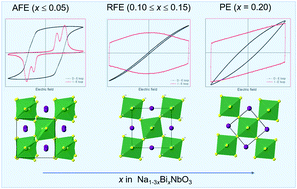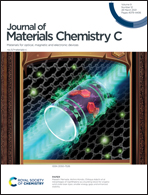Tunable phase transitions in NaNbO3 ceramics through bismuth/vacancy modification†
Abstract
Sodium niobate, NaNbO3, which exhibits a perovskite structure, has recently stimulated interest in the field of energy storage capacitors, with derived solid solutions shown to have promising energy storage densities. Here A-site Bi/vacancy doping in NaNbO3 in the system Na1−3xBixV2xNbO3 (where V = vacancy and x = 0.015, 0.05, 0.10, 0.15 and 0.20) is investigated. Phase evolution was systematically examined through X-ray powder diffraction, Raman spectroscopy and thermal analysis, and is found to correlate with changes in electrical behaviour. It is shown that through tuning the Bi/vacancy content, different high temperature phases (above 550 °C) of NaNbO3, including the tetragonal P4/mbm and cubic Pm![[3 with combining macron]](https://www.rsc.org/images/entities/char_0033_0304.gif) m phases are stabilised at room temperature. The phase evolution from Pbcm (x = 0.015 and 0.05) to P4/mbm (x = 0.10 and 0.15) to Pm
m phases are stabilised at room temperature. The phase evolution from Pbcm (x = 0.015 and 0.05) to P4/mbm (x = 0.10 and 0.15) to Pm![[3 with combining macron]](https://www.rsc.org/images/entities/char_0033_0304.gif) m (x = 0.20) with increased Bi/vacancy content is accompanied by lattice expansion, which is explained in terms of the accommodation of increased disorder resulting from the mixed arrangement of species (xBi3+, (1 − x)Na+ and 2xVNa) on the A-site. Bismuth/vacancy modification of NaNbO3 is seen to induce relaxor-like behaviour, significantly increasing both the recoverable energy storage density and energy storage efficiency.
m (x = 0.20) with increased Bi/vacancy content is accompanied by lattice expansion, which is explained in terms of the accommodation of increased disorder resulting from the mixed arrangement of species (xBi3+, (1 − x)Na+ and 2xVNa) on the A-site. Bismuth/vacancy modification of NaNbO3 is seen to induce relaxor-like behaviour, significantly increasing both the recoverable energy storage density and energy storage efficiency.



 Please wait while we load your content...
Please wait while we load your content...